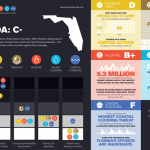Which U.S. States Are Most responsible for local weather change? This handy image Will exhibit You
simply 10 states account for nearly half of of the nation’s carbon footprint.
August 5, 2015
The Obama Administration’s not too long ago-finalized smooth energy Plan units practicable objectives for each and every state to cut back its carbon emissions. however it does not say precisely how. it’s up to each and every state to choose from a battery of measures, from switching faraway from coal to gasoline power, to enacting vitality effectivity and carbon tax programs.
The image right here gives a way of the task at hand. Put together via the World tools Institute, it presentations which states have the greatest emissions and where those emissions come from, together with transport, electrical energy generation, and industrial causes.
the large takeaway is that some states are way more accountable for climate trade than others. just 10 account nearly half the general burden, with Texas (12.5%), California (7%) and Pennsylvania (4.3%) the most polluting states. in contrast, the 10 states with the least emissions account for just three% of emissions total.
electricity manufacturing represents more than 30% of complete emissions, however that sector’s contribution to state-by way of-state emissions varies. In West Virginia and Kentucky, two big coal producers, it makes up greater than 50% of the whole, for example, whereas in Vermont and Idaho its role is negligible.
WRI factors out that energy efficiency requirements are most often an economically environment friendly way to scale back climate impacts. Its diagnosis shows that 24 states have saved a normal of $2-$5 for every $1 invested. that’s additionally the Obama Administration’s thinking, too. though it desires to states to move in opposition to gasoline, sunlight, and wind energy at the price of coal, it additionally sees a lot of mileage in additional efficient automobiles, constructions, and home equipment. These measures get monetary savings, increase the financial system they usually do not include the political baggage of different climate measures.
For more charts and graphs, see WRI’s local weather knowledge Explorer instrument right here.
[top photo: ChiccoDodiFC by way of Shutterstock]
(99)














